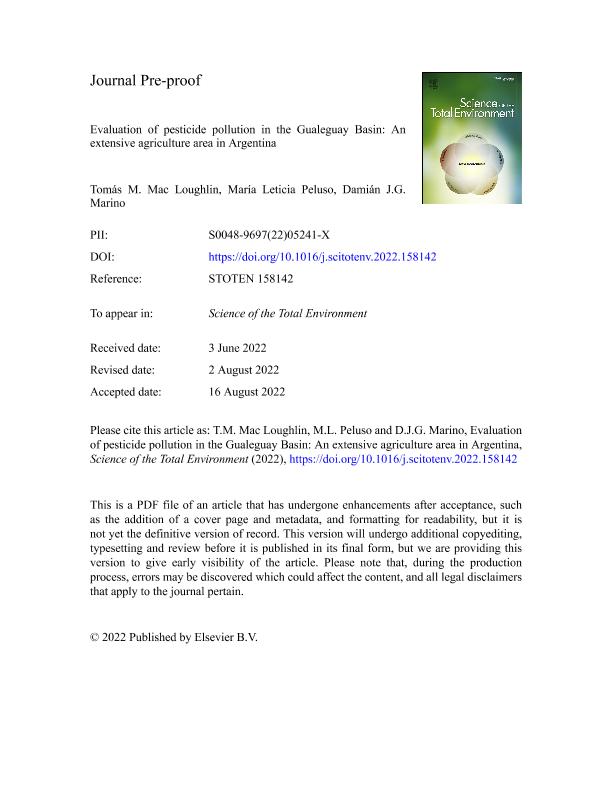Artículo
Evaluation of pesticide pollution in the Gualeguay Basin: An extensive agriculture area in Argentina
Fecha de publicación:
12/2022
Editorial:
Elsevier
Revista:
Science of the Total Environment
ISSN:
0048-9697
Idioma:
Inglés
Tipo de recurso:
Artículo publicado
Clasificación temática:
Resumen
The current agricultural production model was established in the 1990s based on the use of genetically modified organisms and agrochemicals, mainly pesticides. Despite pesticide spread and prevalence, data on the associated concentrations in surface watercourses are comparatively scarce. The aim of this work was to evaluate to what extent the >20 years of agricultural activity with the use of pesticides has impacted on the Gualeguay-River basin, with respect to the different stream orders: the tributary streams and main channel. Thirteen sites within the lower Gualeguay basin were sampled once every season (autumn, winter, spring, and summer) in 2017–2018. The samples were analyzed by gas chromatography time-of-flight mass-spectrometry (GC-TOF-MS) and ultraperformance liquid chromatography tandem mass-spectrometry (UPLC-MS/MS). The most frequently detected pesticide was glyphosate along with its metabolite (aminomethyl)phosphonic acid (AMPA), at 82 % and 71 % of surface water samples and 97 % and 92 % of bottom sediments, respectively; followed by atrazine in 73 % of the water samples. The concentrations of these compounds, each in their respective matrices, did not present sufficient statistically significant differences for differentiating a tributary stream from the main channel. Regardless of glyphosate's affinity for the suspended particulate and bottom sediments, over the entire basin the soluble fraction contributed on average to >80 % of the total concentration in surface water. Despite not being so frequently detected, certain insecticides, mostly deltamethrin, were likewise detected at concentrations above their water-quality guidelines for the protection of aquatic life, even in samples from the main channel. Upon comparison of the pesticide profiles of extensive- and horticultural-production systems in the country, atrazine emerged as a prime candidate to be used as a tracer of extensive agriculture contamination in the environment. Further research is required to establish to what degree pesticides used in agriculture and mobilized by watercourses have an impact on their associated wetland ecosystems.
Palabras clave:
ATRAZINE
,
GLYPHOSATE
,
MASS SPECTROMETRY
,
PSEUDOPERSISTENCE
,
SOYBEAN
Archivos asociados
Licencia
Identificadores
Colecciones
Articulos (CIM)
Articulos de CENTRO DE INVESTIGACIONES DEL MEDIO AMBIENTE
Articulos de CENTRO DE INVESTIGACIONES DEL MEDIO AMBIENTE
Citación
Mac Loughlin, Tomas Mariano; Peluso, María Leticia; Marino, Damian Jose Gabriel; Evaluation of pesticide pollution in the Gualeguay Basin: An extensive agriculture area in Argentina; Elsevier; Science of the Total Environment; 851; 12-2022; 1-16
Compartir
Altmétricas




